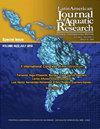罗氏沼虾在生物定位系统中培养后幼体日粮蛋白质/脂质水平的变化
IF 0.8
4区 农林科学
Q3 FISHERIES
Latin American Journal of Aquatic Research
Pub Date : 2023-02-28
DOI:10.3856/vol51-issue1-fulltext-2924
引用次数: 2
摘要
进行了一项为期70天的实验试验,以评估在零水交换培养箱中喂食不同粗蛋白(P)和脂质(L)水平的罗氏沼虾(PL)(平均82.00±19.71mg)的生物块对其营养的贡献。采用6种生物肥处理(BFT)作为试验日粮,其中P水平为15%、20%或25%,L水平为5%或8%:BFT-15/5;BFT-15/8;BFT-20/5;BFT-20/8;BFT-25/5;BFT-25/8和添加有25%P和8%L的无生物絮凝的清水对照(CW-25/8)。实验在21-60L的塑料罐中一式三份进行,该塑料罐包含10个对虾罐-1。实验结束时,对虾的存活率在66%以上,各实验组之间无显著差异(P>0.05),BFT-20/5对虾饲料转化率显著低于对照组(P<0.001);结果表明,采用低浓度P(20%)和低浓度L(5%)的日粮,在生物定位系统中培育巨型淡水对虾PL是可行的。结果还表明,生物块有助于培养淡水对虾PL对磷和L的需求,表现为饲料利用率、磷保持率和生长性能的提高。本文章由计算机程序翻译,如有差异,请以英文原文为准。
Variation of dietary protein/lipid levels used in postlarvae of freshwater prawn Macrobrachium rosenbergii cultured in a biofloc system
A 70-day experimental trial was performed to evaluate the contribution of biofloc to the nutrition of Macrobrachium rosenbergii 15 days old postlarvae (PL) (average 82.00 ± 19.71 mg) fed different crude protein (P) and lipids (L) levels in zero-water exchange culture tanks. Six biofloc treatments (BFT) as experimental diets with 15, 20, or 25% P levels and 5 or 8% L levels were managed: BFT-15/5; BFT-15/8; BFT-20/5; BFT-20/8; BFT-25/5; BFT-25/8, and a clear-water control without biofloc fed with 25% P and 8% L (CW-25/8). The experiment was done in triplicate in 21-60 L plastic tanks containing 10 prawns tank-1. At the end of the experiment, survival of prawns was above 66%, with no significant differences among experimental groups (P > 0.05). The best growth performance was observed in the experimental prawns maintained in BFT-20/5, BFT-20/8, BF-25/5, and BFT-25/8 compared to the control (P < 0.001). The feed conversion rate of the prawns in BFT-20/5 was significantly lower than that in control (P < 0.001); the best P efficiency ratio and productive P value were observed in all BFT compared to control prawns (P < 0.001). Results showed that it is feasible to use low concentrations of P (20%) and L (5%) in diets to grow giant freshwater prawn PL in a biofloc system. Results also demonstrated that biofloc contributes to the P and L requirements of cultured freshwater prawn PL, as indicated by improved feed utilization, P retention, and growth performance.
求助全文
通过发布文献求助,成功后即可免费获取论文全文。
去求助
来源期刊

Latin American Journal of Aquatic Research
FISHERIES-MARINE & FRESHWATER BIOLOGY
CiteScore
1.70
自引率
10.00%
发文量
44
审稿时长
4-8 weeks
期刊介绍:
Latin American Journal of Aquatic Research- LAJAR is the continuation of the journal Investigaciones Marinas (1970-2007) and is published since 2008 by the Escuela de Ciencias del Mar, Facultad de Ciencias del Mar y Geografía of the Pontificia Universidad Católica de Valparaíso. LAJAR is an “Open Access” journal that publishes in English language, original research articles, reviews and short communications on aquatic science, which contain the results of research conducted in aquaculture or in oceanic and coastal marine waters of Latin America.
The following topics are considered: Physical Oceanography, Chemical Oceanography, Marine Biogeochemistry, Marine Pollution and Toxicology, Marine Geology and Geophysics, Biological Oceanography, Fisheries and Aquaculture.
 求助内容:
求助内容: 应助结果提醒方式:
应助结果提醒方式:


